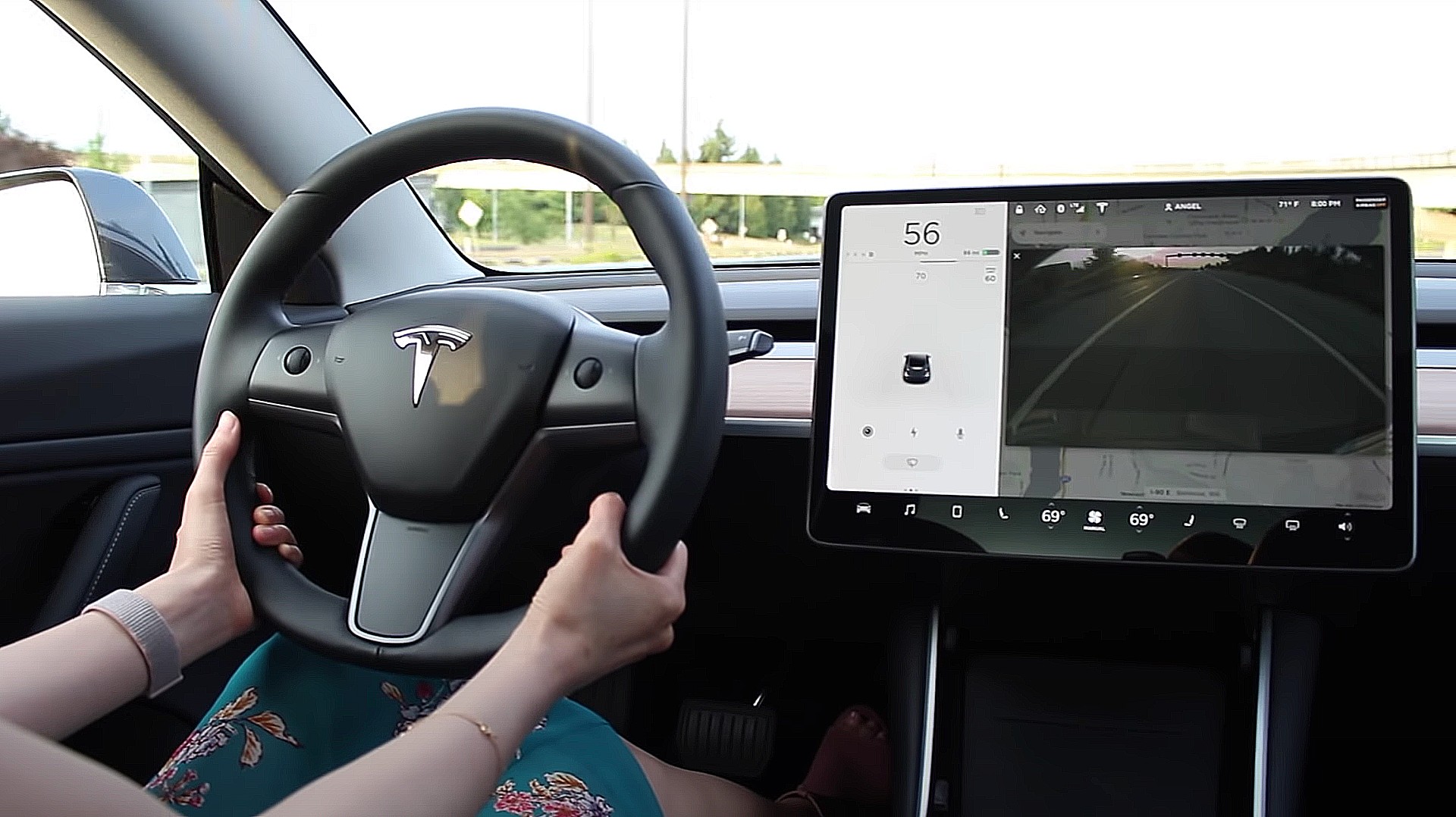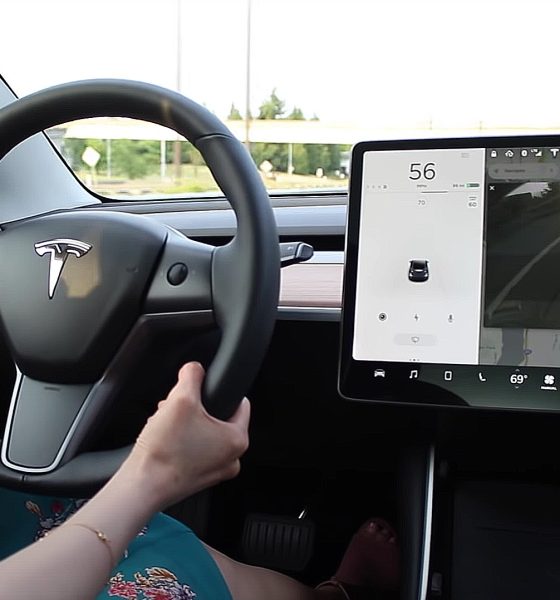

News
This Tesla analyst just destroyed the Consumer Reports self-driving trick test
Tesla analyst Pierre Ferragu of New Street Research is not impressed with Consumer Reports’ test that apparently “tricked” a Model Y into driving itself without anyone in the passenger seat.
Earlier this week, Consumer Reports claims that it made a Model Y drive itself by “tricking” it with a series of weights, contraptions, and loopholes that everyday drivers would never use. The experiment concluded that Tesla’s self-driving systems could operate without a driver in the driver’s seat, but many weren’t impressed with the study’s findings.
Now, Ferragu is commenting on the CR experiment, and he destroyed the testing process along with the overall results of the test.
“Consumer Report showed you can trick à tesla to self-drive without a driver. This car is dangerous! Stop selling it! I just showed you can drive an F150 with windows open, a machine gun in your hands, and shoot around random bullets. This car is dangerous! Stop selling it,” Ferragu said in a satirical Twitter post.
Consumer Report showed you can trick à tesla to self drive without a driver. This car is dangerous! Stop selling it! I just showed you can drive an F150 with windows open, a machine gun in your hands, and shoot around random bullets. This car is dangerous! Stop selling it!
— Pierre Ferragu (@p_ferragu) April 24, 2021
While CR was attempting to prove that Tesla’s Autopilot and Full-Self Driving systems could operate without anyone specifically monitoring the wheel, the experiment was unrealistic in terms of what everyday people would do. It seems that if someone wanted their car to drive itself, they could make it do it, but there would be a series of loopholes that the owner would have to jump through to make this happen. Ultimately, any car could be subjected to a test where it makes its operation look completely unfavorable. Anything on Earth can be outsmarted, but the people doing it must know that they’re attempting to do something dangerous at their own risk. It is tough to see how Tesla could be blamed or held liable for owners “tricking” the FSD sensors, which monitor the driver’s hands on the steering wheel, along with the weight in the seat.
Tesla has never indicated that its cars can drive themselves, and Level 5 autonomy, which would make a car operate without any interventions from the driver, has been discussed by Elon Musk in the past. Musk said in late 2020 that he was “extremely confident of achieving full autonomy and releasing it to the Tesla customer base next year.” He has not commented on Tesla’s potential capabilities since then.
Ferragu, a notable Tesla bull, is one of the most realistic analysts on Wall Street when it comes to the carmaker. While he is a Tesla owner, he is also a valuable critic of the company. He is candid with his synopsis of its outlook when adjusting price targets or releasing investor notes and has dropped his price target when the automaker isn’t performing at its best. With that being said, Ferragu has experienced Autopilot for himself in his own car, and in February, he talked about its impressive performance on a 70-mile highway drive.
Did autopilot get a material update recently? I just drove 70 miles of complex highway. Zero touch, I was blown away. For the first time I thought the car behaved like a human in slip roads, densifying traffic, changing lanes, and most importantly when facing unclear situations.
— Pierre Ferragu (@p_ferragu) February 12, 2021
When it comes down to it, drivers ultimately hold the responsibility of using Autopilot and Full Self-Driving systems. Even if the system was “tricked” by Consumer Reports, their testing process was questionable, and it is likely that very few people would be willing to let their cars operate through a loophole, especially when Tesla indicates that drivers hold the ultimate responsibility of paying attention to the road and its conditions while operating their all-electric motor vehicle.
Disclosure: Joey Klender is a TSLA Shareholder.

Elon Musk
Elon Musk’s X will start using a Tesla-like software update strategy
The initiative seems designed to accelerate updates to the social media platform, while maintaining maximum transparency.

Elon Musk’s social media platform X will adopt a Tesla-esque approach to software updates for its algorithm.
The initiative seems designed to accelerate updates to the social media platform, while maintaining maximum transparency.
X’s updates to its updates
As per Musk in a post on X, the social media company will be making a new algorithm to determine what organic and advertising posts are recommended to users. These updates would then be repeated every four weeks.
“We will make the new 𝕏 algorithm, including all code used to determine what organic and advertising posts are recommended to users, open source in 7 days. This will be repeated every 4 weeks, with comprehensive developer notes, to help you understand what changed,” Musk wrote in his post.
The initiative somewhat mirrors Tesla’s over-the-air update model, where vehicle software is regularly refined and pushed to users with detailed release notes. This should allow users to better understand the details of X’s every update and foster a healthy feedback loop for the social media platform.
xAI and X
X, formerly Twitter, has been acquired by Elon Musk’s artificial intelligence startup, xAI last year. Since then, xAI has seen a rapid rise in valuation. Following the company’s the company’s upsized $20 billion Series E funding round, estimates now suggest that xAI is worth tens about $230 to $235 billion. That’s several times larger than Tesla when Elon Musk received his controversial 2018 CEO Performance Award.
As per xAI, the Series E funding round attracted a diverse group of investors, including Valor Equity Partners, Stepstone Group, Fidelity Management & Research Company, Qatar Investment Authority, MGX, and Baron Capital Group, among others. Strategic partners NVIDIA and Cisco Investments also continued support for building the world’s largest GPU clusters.
News
Tesla FSD Supervised wins MotorTrend’s Best Driver Assistance Award
The decision marks a notable reversal for the publication from prior years, with judges citing major real-world improvements that pushed Tesla’s latest FSD software ahead of every competing ADAS system.

Tesla’s Full Self-Driving (Supervised) system has been named the best driver-assistance technology on the market, earning top honors at the 2026 MotorTrend Best Tech Awards.
The decision marks a notable reversal for the publication from prior years, with judges citing major real-world improvements that pushed Tesla’s latest FSD software ahead of every competing ADAS system. And it wasn’t even close.
MotorTrend reverses course
MotorTrend awarded Tesla FSD (Supervised) its 2026 Best Tech Driver Assistance title after extensive testing of the latest v14 software. The publication acknowledged that it had previously criticized earlier versions of FSD for erratic behavior and near-miss incidents, ultimately favoring rivals such as GM’s Super Cruise in earlier evaluations.
According to MotorTrend, the newest iteration of FSD resolved many of those shortcomings. Testers said v14 showed far smoother behavior in complex urban scenarios, including unprotected left turns, traffic circles, emergency vehicles, and dense city streets. While the system still requires constant driver supervision, judges concluded that no other advanced driver-assistance system currently matches its breadth of capability.
Unlike rival systems that rely on combinations of cameras, radar, lidar, and mapped highways, Tesla’s FSD operates using a camera-only approach and is capable of driving on city streets, rural roads, and freeways. MotorTrend stated that pure utility, the ability to handle nearly all road types, ultimately separated FSD from competitors like Ford BlueCruise, GM Super Cruise, and BMW’s Highway Assistant.
High cost and high capability
MotorTrend also addressed FSD’s pricing, which remains significantly higher than rival systems. Tesla currently charges $8,000 for a one-time purchase or $99 per month for a subscription, compared with far lower upfront and subscription costs from other automakers. The publication noted that the premium is justified given FSD’s unmatched scope and continuous software evolution.
Safety remained a central focus of the evaluation. While testers reported collision-free operation over thousands of miles, they noted ongoing concerns around FSD’s configurable driving modes, including options that allow aggressive driving and speeds beyond posted limits. MotorTrend emphasized that, like all Level 2 systems, FSD still depends on a fully attentive human driver at all times.
Despite those caveats, the publication concluded that Tesla’s rapid software progress fundamentally reshaped the competitive landscape. For drivers seeking the most capable hands-on driver-assistance system available today, MotorTrend concluded Tesla FSD (Supervised) now stands alone at the top.
News
Elon Musk’s Grokipedia surges to 5.6M articles, almost 79% of English Wikipedia
The explosive growth marks a major milestone for the AI-powered online encyclopedia, which was launched by Elon Musk’s xAI just months ago.

Elon Musk’s Grokipedia has grown to an impressive 5,615,201 articles as of today, closing in on 79% of the English Wikipedia’s current total of 7,119,376 articles.
The explosive growth marks a major milestone for the AI-powered online encyclopedia, which was launched by Elon Musk’s xAI just months ago. Needless to say, it would only be a matter of time before Grokipedia exceeds English Wikipedia in sheer volume.
Grokipedia’s rapid growth
xAI’s vision for Grokipedia emphasizes neutrality, while Grok’s reasoning capabilities allow for fast drafting and fact-checking. When Elon Musk announced the initiative in late September 2025, he noted that Grokipedia would be an improvement to Wikipedia because it would be designed to avoid bias.
At the time, Musk noted that Grokipedia “is a necessary step towards the xAI goal of understanding the Universe.”
Grokipedia was launched in late October, and while xAI was careful to list it only as Version 0.1 at the time, the online encyclopedia immediately earned praise. Wikipedia co-founder Larry Sanger highlighted the project’s innovative approach, noting how it leverages AI to fill knowledge gaps and enable rapid updates. Netizens also observed how Grokipedia tends to present articles in a more objective manner compared to Wikipedia, which is edited by humans.
Elon Musk’s ambitious plans
With 5,615,201 total articles, Grokipedia has now grown to almost 79% of English Wikipedia’s article base. This is incredibly quick, though Grokipedia remains text-only for now. xAI, for its part, has now updated the online encyclopedia’s iteration to v0.2.
Elon Musk has shared bold ideas for Grokipedia, including sending a record of the entire knowledge base to space as part of xAI’s mission to preserve and expand human understanding. At some point, Musk stated that Grokipedia will be renamed to Encyclopedia Galactica, and it will be sent to the cosmos.
“When Grokipedia is good enough (long way to go), we will change the name to Encyclopedia Galactica. It will be an open source distillation of all knowledge, including audio, images and video. Join xAI to help build the sci-fi version of the Library of Alexandria!” Musk wrote, adding in a later post that “Copies will be etched in stone and sent to the Moon, Mars and beyond. This time, it will not be lost.”








